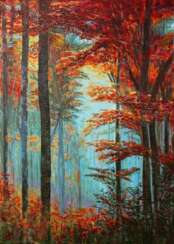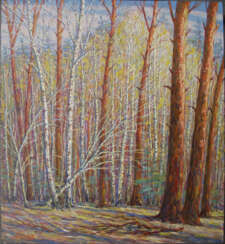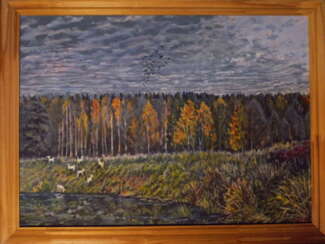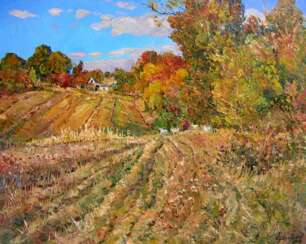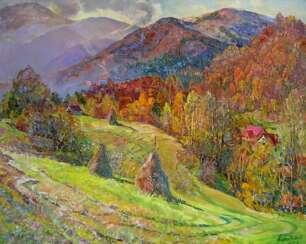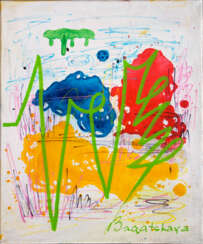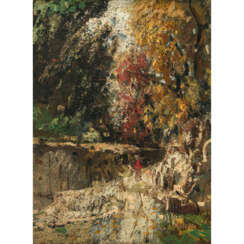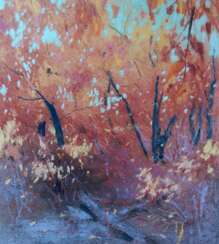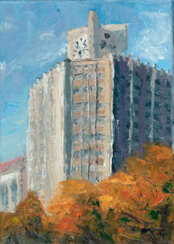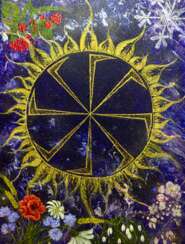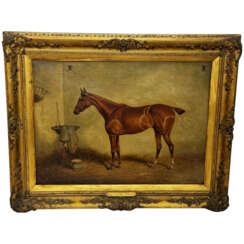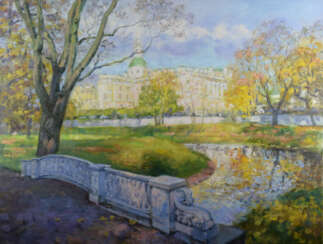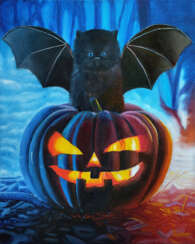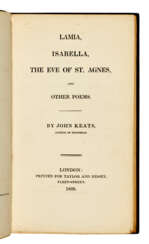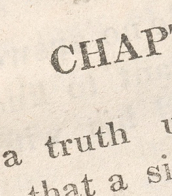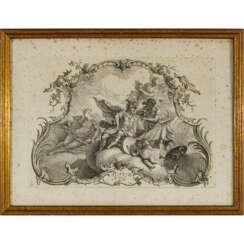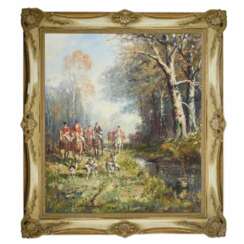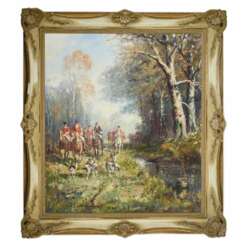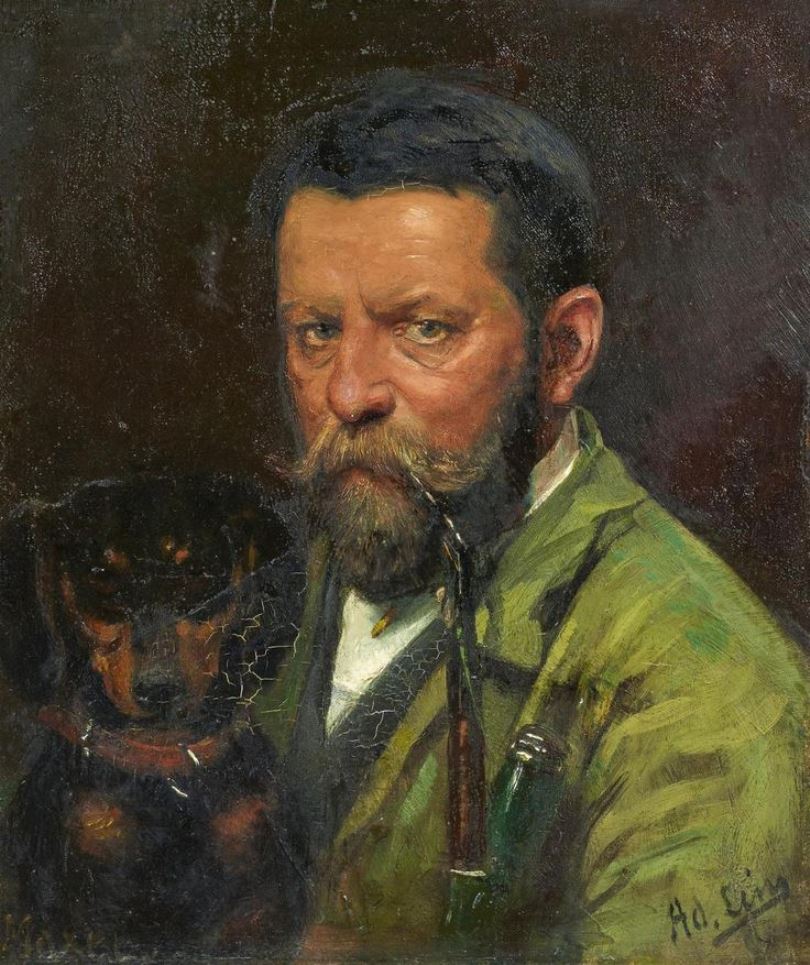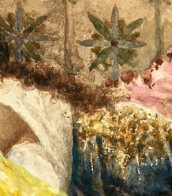133 Items by auctions and galleries:
autumn forest
Autumn forest
DMYTRO YEROMENKO (b. 1963)  Shop YEROMENKO DMYTRO
Shop YEROMENKO DMYTRO
DMYTRO YEROMENKO
19.11.1963
Ukraine
Дмитрий Ерёменко - художник-любитель, базирующийся в Мариуполе, Украина.
Путешествуя по Европе, Дмитрий профессионально исполняет фотографии, которые помогают ему в отношениях с изобразительным искусством.
Часто Дмитрию удается работать на пленэрах в Испании, Украине и Франции.
В своих работах, в основном выполненных по технике масляного акрила, художник изображает натюрморты, красоту морских пейзажей, достопримечательности столиц мира и виды его родной Украины.
Наиболее активно Дмитрий работает с 2017 года.
Его картины имеются в частных коллекциях в США, Испании, Великобритании и Украине. Отпечатки его произведений продаются в Европе и Соединенных Штатах Америки.
Artist shop
YEROMENKO DMYTRO
Ukraine
Number of products: 38
Goats at the pasture
Artyom Ukhov (b. 1982)  Shop Ukhov Artyom
Shop Ukhov Artyom

Artyom Ukhov
20.01.1982
Russia
Artist and designer, has 15 exhibitions and 3 rewards
Ухов Артем Евгеньевич,
1982 г.р., г. Череповец, Вологодской области,
КОНТАКТЫ:
vk.com: uae82
Exhibitions:
Personal exhibition in Ustuzhna district library of K.N.Batushkov, June – August 2018, Ustuzhna town;
Art-Start, young modern art, Krasny most gallery, May, 30th – July 1st, Vologda city;
Russian Art Week, XXIV International Exhibition & Competition of Modern and Contemporary Art, Moscow, April, 23rd – 29th,
Vologda Regional Exhibition “Orthodoxian Vologda” April, 25th – June 2nd2018, Vologda city.
Vologda Regional Exhibition dedicated to the 870th anniversary of Vologda city, September, 22nd – October, 30th 2017, Vologda city.
“Shire krug 8” Annual art exhibition of young artist of Vologda city Nov, 1st, 2016 – Feb, 5th, 2017;
“Shire krug 7” Annual art exhibition of young artist of Vologda city Dec, 23rd, 2015 -Feb,20th, 2016;
Personal exhibition in Ustuzhna district library of K.N.Batushkov, Dec, 2015 — Jan, 2016;
«ArtExpoSPb 2016», October, 21st-23rd 2016, Saint Petersburg, Russian Federation.
Personal art exhibition in Vologda State Technical University Library, October-november 2012;
Prizes:
2nd place in “Painting” nomination of Russian Art Week, XXIV International Exhibition & Competition of Modern and Contemporary Art, Moscow, April, 23rd – 29th, 2018.
1st place in “subject picture” nomination of Saint-Petersburg Art Week, X International Exhibition & Competition of Contemporary Arts, Saint-Petersburg, April, 28th – May, 3rd, 2018.
3nd place in “genre picture” nomination of Russian Art Week, XXVI International Exhibition & Competition of Modern and Contemporary Art, Moscow, April, 8rd – 14th, 2019.

Artist shop
Ukhov Artyom
Russia
Number of products: 62
Autumn in the forest
Ivan Ormanzhi (b. 1976)  Shop Ormanzhi Ivan
Shop Ormanzhi Ivan

Ivan Ormanzhi
12.03.1976
Ukraine
I'm not professional artist, because I ern money by another profession. I'm a web developer from Ukraine, but painting time after time all of my life. For fun, for my games and for my web sites. I'm happy when I paint and I see that many people like my artworks. It's a good reason not to stop.
I didn't graduate any Art School... Yes, It's not a reason to pride, but in our time, with the Internet we can study everything at home. It doesn't matter what do you do... but it matters that you do it with love.

Artist shop
Ormanzhi Ivan
Ukraine
Number of products: 32
Velvet Autumn Painting by Aleksandr Dubrovskyy
Aleksandr Dubrovskyy (b. 1949) 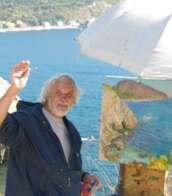 Shop Dubrovskyy Aleksandr
Shop Dubrovskyy Aleksandr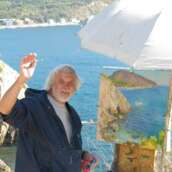

Aleksandr Dubrovskyy
10.06.1949
Ukraine
https://mssg.me/dubrovskyy
1949: Alexandr Dubrovskyy Ukrainian painter - impressionist
1956-1965: Studies at the studio of fine arts in Enakievo (Ukraine)
1969: Graduates from Kharkiv State Art School (professor Tanpeter, Ukraine)
1972-1984: Participated in numerous prestigious personal and collective exhibitions of the Soviet Union and abroad
1973-1975: Exhibitions of contemporary Soviet art (Tokyo, Kyushu, Japan)
1973-1984: Creative trips to the art center of SEDNIV (Ukraine). Worked together with and learned at the same time from outstanding painters such as Konstantyn Lomykin, Fedor Zakharov, Nikolay Glushchenko, Viktor Shatalin, and Tatyana Yablonskaya.
1984-2019: Participated in the personal and collective exhibition all around Ukraine and abroad
1985-1993: International exhibitions of contemporary art (Algeria)
1987: Member of National Union of Artists of Ukraine
1992: An exhibition of artists of the St. Petersburg School of Painting (ARCOLE Gallery, Paris, France)
1995-2004: Designed & Created mosaic panels at the Cathedral of Saint Mina (Alexandria, Egypt)
2003-2005: Designed & Created mosaics in St.George's Cathedral of Vydubitsky Monastery (Kyiv, Ukraine)
2007-2020: Exhibitions of Plein Air painting (All around Ukraine and abroad)
Permanent exhibitions:
• Museum "Art Gallery" in the Golitsyn Palace (Trostyanets, Sumy region, Ukraine)
• Horlivka Art Museum - shows the painting of the Soviet period (Horlivka, Donetsk region, Ukraine).
• Lebedin City Art Museum. B.K. Rudneva (Lebedin, Sumy region, Ukraine)

Artist shop
Dubrovskyy Aleksandr
Ukraine
Number of products: 37
Clear autumn midday Painting by Aleksandr Dubrovskyy
Aleksandr Dubrovskyy (b. 1949)  Shop Dubrovskyy Aleksandr
Shop Dubrovskyy Aleksandr

Aleksandr Dubrovskyy
10.06.1949
Ukraine
https://mssg.me/dubrovskyy
1949: Alexandr Dubrovskyy Ukrainian painter - impressionist
1956-1965: Studies at the studio of fine arts in Enakievo (Ukraine)
1969: Graduates from Kharkiv State Art School (professor Tanpeter, Ukraine)
1972-1984: Participated in numerous prestigious personal and collective exhibitions of the Soviet Union and abroad
1973-1975: Exhibitions of contemporary Soviet art (Tokyo, Kyushu, Japan)
1973-1984: Creative trips to the art center of SEDNIV (Ukraine). Worked together with and learned at the same time from outstanding painters such as Konstantyn Lomykin, Fedor Zakharov, Nikolay Glushchenko, Viktor Shatalin, and Tatyana Yablonskaya.
1984-2019: Participated in the personal and collective exhibition all around Ukraine and abroad
1985-1993: International exhibitions of contemporary art (Algeria)
1987: Member of National Union of Artists of Ukraine
1992: An exhibition of artists of the St. Petersburg School of Painting (ARCOLE Gallery, Paris, France)
1995-2004: Designed & Created mosaic panels at the Cathedral of Saint Mina (Alexandria, Egypt)
2003-2005: Designed & Created mosaics in St.George's Cathedral of Vydubitsky Monastery (Kyiv, Ukraine)
2007-2020: Exhibitions of Plein Air painting (All around Ukraine and abroad)
Permanent exhibitions:
• Museum "Art Gallery" in the Golitsyn Palace (Trostyanets, Sumy region, Ukraine)
• Horlivka Art Museum - shows the painting of the Soviet period (Horlivka, Donetsk region, Ukraine).
• Lebedin City Art Museum. B.K. Rudneva (Lebedin, Sumy region, Ukraine)

Artist shop
Dubrovskyy Aleksandr
Ukraine
Number of products: 37
Beautiful autumn in the mountains
Aleksandr Dubrovskyy (b. 1949)  Shop Dubrovskyy Aleksandr
Shop Dubrovskyy Aleksandr

Aleksandr Dubrovskyy
10.06.1949
Ukraine
https://mssg.me/dubrovskyy
1949: Alexandr Dubrovskyy Ukrainian painter - impressionist
1956-1965: Studies at the studio of fine arts in Enakievo (Ukraine)
1969: Graduates from Kharkiv State Art School (professor Tanpeter, Ukraine)
1972-1984: Participated in numerous prestigious personal and collective exhibitions of the Soviet Union and abroad
1973-1975: Exhibitions of contemporary Soviet art (Tokyo, Kyushu, Japan)
1973-1984: Creative trips to the art center of SEDNIV (Ukraine). Worked together with and learned at the same time from outstanding painters such as Konstantyn Lomykin, Fedor Zakharov, Nikolay Glushchenko, Viktor Shatalin, and Tatyana Yablonskaya.
1984-2019: Participated in the personal and collective exhibition all around Ukraine and abroad
1985-1993: International exhibitions of contemporary art (Algeria)
1987: Member of National Union of Artists of Ukraine
1992: An exhibition of artists of the St. Petersburg School of Painting (ARCOLE Gallery, Paris, France)
1995-2004: Designed & Created mosaic panels at the Cathedral of Saint Mina (Alexandria, Egypt)
2003-2005: Designed & Created mosaics in St.George's Cathedral of Vydubitsky Monastery (Kyiv, Ukraine)
2007-2020: Exhibitions of Plein Air painting (All around Ukraine and abroad)
Permanent exhibitions:
• Museum "Art Gallery" in the Golitsyn Palace (Trostyanets, Sumy region, Ukraine)
• Horlivka Art Museum - shows the painting of the Soviet period (Horlivka, Donetsk region, Ukraine).
• Lebedin City Art Museum. B.K. Rudneva (Lebedin, Sumy region, Ukraine)

Artist shop
Dubrovskyy Aleksandr
Ukraine
Number of products: 37
Autumn
Nataliia Bahatska (b. 1967) 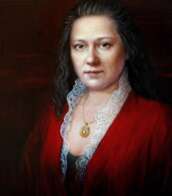 Shop Bahatska Nataliia
Shop Bahatska Nataliia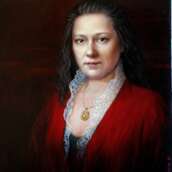

Nataliia Bahatska
20.10.1967
Ukraine
I was born in 1967.
Graduated childrens art school.
Graduated from Kyiv National University of Design, designer in 1993.
Academy of Psychosocial Technologies in 2008
The artworks are in Ukraine, Lithuania, Kazakhstan, Russia, Germany, Sweden, Switzerland, Italy, France, UK, USA, Vietnam, Canada, Netherlands.
Recently, all paintings have been created in hyperrealism and pop art.
Exhibition "Pro Cheese", ArtHall "D12", Kiev, 2021.
IV Ukrainian Festival of Contemporary Women's Art at the Institute of Contemporary Art of the National Academy of Arts of Ukraine, Kyiv, Ukraine, 2021
International exhibition "# 365daysafter" in the gallery "Artist", Kyiv, 2021. Exhibition "HRYVNA ART" in the Palace of Arts, Lviv, 2021.
Exhibition "HRYVNA ART" in the Museum of History of Kyiv, Kyiv, 2021.
Exhibition "HRYVNA ART" in the Ministry of Finance of Ukraine, Kyiv, 2021.
Exhibition at the Sky Mall, Kiev. 2021
Competition Pro Cheese Awards, Kiev, Parkovy Exhibition and Convention Center. Grand Prix. 2021
Exhibition "Барви світу" in Parlament of Ukraine. Kyiv. Ukraine, 2019
Sheldon Rose Gallery, "Big Ideas in Small Art", Toronto, Canada, 2019
Group exhibition from Ukraine at 58 Venice Biennale, "Falling shadow Dreams over gardens Giardini ". Italy, 2019
Exhibition "Vizionario" in la galleria Merlino Bottega d'arte di Firenze. Italy, 2019
Exhibition in ABC-art gallery. Kyiv, 2019
1st All-Ukrainian Triennale "NU-ART", Kremenchuk, 2018
"Ukraine from Trypillya to the present in the images of contemporary artists" - Biennial. National Union of Artists of Ukraine (NUAU), Kyiv, 2018
"Picturesque Ukraine", NUAU,the city of Severodonetsk, 2017.
Biennale of abstract Painting,NUAU, Kyiv, 2017
Until the Day of the Artist, NUAU, Kyiv, 2016, 2017, 2018.
"Portrait Painting" , gallery "Mytets", Kyiv, 2017
"To the 160th anniversary of Ivan Franko",NUAU, Ivano-Frankivsk city, 2016
On Independence Day of Ukraine, NUAU, Kyiv, 2017, 2018,
When buying, please specify the payment and delivery methods.

Artist shop
Bahatska Nataliia
Ukraine
Number of products: 231
THE BIRD'S ISLAND.
Sergiy Roy (b. 1958) 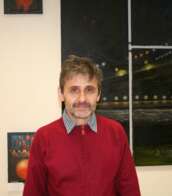 Shop Roy Sergiy
Shop Roy Sergiy

Sergiy Roy
04.04.1958
Ukraine
EXHIBITIONS:
INTERNATIONAL ART EXHIBITION,
MOSKOW, RUSSIA, WARSAW, POLAND, 1984
BASHKIRTSEV’S ART EXHIBITION, MUSEUM OF FINE ART, POLTAVA, UKRAINE, 1988
AVAN/ART IN ROVANIEMI, FINLAND, 1990
ANNUAL NATIONAL ART EXHIBITION, KYIV, UKRAINE, 1990
AVAN/ART, MUSEUM OF FINE ART, MURMANSK, RUSSIA, 1990
AVAN/ART IN JACKSONVILLE, KENT GALLERY, JACKSONVILLE, FLORIDA, USA, 1991
AVAN/ART IN JACKSONVILLE, DAWNTOWN GALLERY, JACKSONVILLE, FLORIDA, USA, 1991
ME+ME+ME+ME+…/AVAN CENTER OF CULTURE MURMANSK, RUSSIA, 1992
NATIONAL EXHIBITION ART GALLERY, KIYV, UKRAINE, 1993
PAN-UKRAINE, DNIPROPETROVSK, UKRAINE, 1995
EXHIBITION MODERN ART GALLERY, POLTAVA, UKRAINE, 2003
REGIONAL EXHIBITION MODERN ART GALLERY, POLTAVA, UKRAINE, 2005
REGIONAL EXHIBITION MODERN ART GALLERY, POLTAVA, UKRAINE, 2007
KYIV-ART. 2008 HOUSE OF TEACHER ,KYIV , UKRAINE 2008
M-ART GALLERY KHARKIV, UKRAINE 2010
IN GARDENS OF VICTORY GALLERY , ODESSA, UKRAINE 2011
Florence Design Week "Crossing People" Exhibition,FLORENCE,ITALY,2013
Gallery Fine ART, POLTAVA,UKRAINE,2013
Gallery " TRYPTYH", KYIV,UKRAINE,2014
Fine ART Gallery ,POLTAVA,UKRAINE,2014
Ukrainian Free Universety, MUNKHEN,GERMANY,2014-2015
ARTGESCHOSS, internationale kunstausstellung, Salzgitter Bad,GERMANY,2017
Art Revolution Taipei,Taiwan , 台北新藝術博覽會,2018
Private collections:
Mr. Roman Kupchinsky (USA, New York)
Dr. Ulf Bethmann (Germany, Hamburg)
Ms. Monika Platek (Poland, Krakov)
Museums and collection:
Jacksonville College (Florida, USA);
Khmelnitsckiy National Art Museum (Ukraine);
Poltava Art Museum (Ukraine);
Modern Art Gallery Poltava (Ukraine);
Austria, Australia, Dubai, USA, Germany, England, Russia, Israel, Irland, New Seland, Taiwan, Ukraine,Poland.

Artist shop
Roy Sergiy
Ukraine
Number of products: 207
Lot 305 Narcisse Virgile Diaz de la Peña. Autumnal forest landscape with a walking woman
Narcisse Virgilio Díaz de la Peña (1807 - 1876) 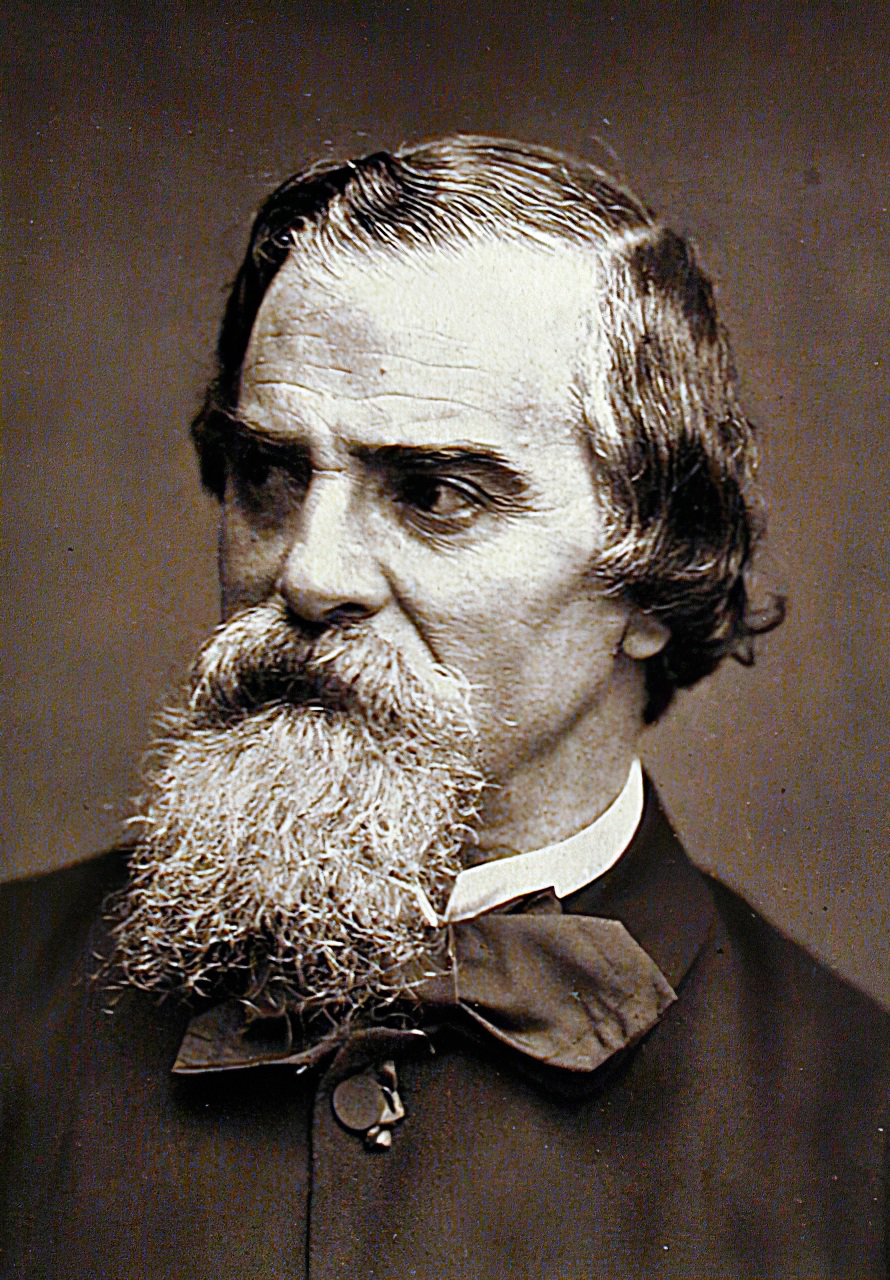 A417: Graphik und Gemälde
A417: Graphik und Gemälde 

Narcisse Virgilio Díaz de la Peña
20.08.1807 - 18.11.1876
France
Narcisse Virgilio Díaz de la Peña was a French painter of the Barbizon school.
Díaz exhibited many pictures at the Paris Salon, and was decorated in 1851 with the rank of Chevalier (Knight) of the Légion d’honneur.

Kunstauktionshaus Neumeister
A417: Graphik und Gemälde
Date: 02.07.2025 16:00 UTC +02:00
Number of lots in the catalog: 158
Ноябрь
Dilshod Khudayorov (b. 1999) 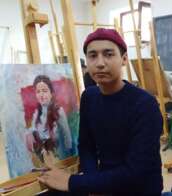 Shop Khudayorov Dilshod
Shop Khudayorov Dilshod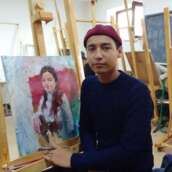

Dilshod Khudayorov
10.11.1999
Uzbekistan
Художник - самоучка, поступивший в университет станковая живопись . Мой стиль реализм в сочетании с авангардом и пишу в направлении импрессионизма. Я не могу не рисовать ни дня . Я всегда работаю над собой и достиг профессионального уровня. У меня нет мастерской . Я люблю рисовать дома в кругу семьи. Вдохновляясь всем, что меня окружает - людьми, природой и древними городами моей страны. Рождаются мои картины.

Artist shop
Khudayorov Dilshod
Uzbekistan
Number of products: 2
Minsk. Watch Factory Luch
Ekaterina Zhuchenko RedHeadKat (b. 1979)  Shop Zhuchenko RedHeadKat Ekaterina
Shop Zhuchenko RedHeadKat Ekaterina

Ekaterina Zhuchenko RedHeadKat
12.08.1979
Byelorussia
EN/RU
.
My name is Ekaterina Zhuchenko, creative pseudonym RedHeadKat.
I have been an artist from an early age. Dad's sketchbook was the greatest treasure. Then I had not dreamed of writing yet
oil. A large set of watercolors in a white plastic box was often secretly taken from the shelf for my
naive art. The thick squirrel brush gave an unforgettable tactile sensation.
But I was able to forget about it "becoming an adult".
I am grateful to the people who helped me return everything. At some point, I realized that I couldn’t stop it. The same set of watercolors, already replenished with new shades. It
became my frequent joy. And oil painting is my discovery and a way to restore connection with my family and father.
.
1996-1999: Minsk Technological College. Fashion designer with a course in painting and acaemic drawing, in-depth study of fashion illustration
2020 to the present day: studying painting in the Graphics studio, Minsk
2021 course of painting with a palette knife at the St. Petersburg School of Oil Painting
Меня зовут Жученко Екатерина, творческий псевдоним RedHeadKat
Я была художником с малых лет. Папин этюдник был самой большой сокровищницей, хоть я тогда и не мечтала писать маслом. Большой набор акварельных красок в белой пласт-
ковой коробке часто в тайне был взят с полки для моего наивного детского искусства, а толстая кисть-белка дарила незабываемые тактильные ощущения.
Но я смогла забыть об этом "став взрослой".
Я благодарна людям, которые помогли мне всё вернуть. В какой-то момент я поняла, что не писть я уже не смогу. Тот самый набор акварели, уже пополненный новыми оттенками, стал моей частой радостью. А живопись маслом — моим способом восстановления связи с родом и отцом.
.
.
.

Artist shop
Zhuchenko RedHeadKat Ekaterina
Byelorussia
Number of products: 21
There was no Sadness, Just the Summer Passed ...
Nataliia Bahatska (b. 1967)  Shop Bahatska Nataliia
Shop Bahatska Nataliia

Nataliia Bahatska
20.10.1967
Ukraine
I was born in 1967.
Graduated childrens art school.
Graduated from Kyiv National University of Design, designer in 1993.
Academy of Psychosocial Technologies in 2008
The artworks are in Ukraine, Lithuania, Kazakhstan, Russia, Germany, Sweden, Switzerland, Italy, France, UK, USA, Vietnam, Canada, Netherlands.
Recently, all paintings have been created in hyperrealism and pop art.
Exhibition "Pro Cheese", ArtHall "D12", Kiev, 2021.
IV Ukrainian Festival of Contemporary Women's Art at the Institute of Contemporary Art of the National Academy of Arts of Ukraine, Kyiv, Ukraine, 2021
International exhibition "# 365daysafter" in the gallery "Artist", Kyiv, 2021. Exhibition "HRYVNA ART" in the Palace of Arts, Lviv, 2021.
Exhibition "HRYVNA ART" in the Museum of History of Kyiv, Kyiv, 2021.
Exhibition "HRYVNA ART" in the Ministry of Finance of Ukraine, Kyiv, 2021.
Exhibition at the Sky Mall, Kiev. 2021
Competition Pro Cheese Awards, Kiev, Parkovy Exhibition and Convention Center. Grand Prix. 2021
Exhibition "Барви світу" in Parlament of Ukraine. Kyiv. Ukraine, 2019
Sheldon Rose Gallery, "Big Ideas in Small Art", Toronto, Canada, 2019
Group exhibition from Ukraine at 58 Venice Biennale, "Falling shadow Dreams over gardens Giardini ". Italy, 2019
Exhibition "Vizionario" in la galleria Merlino Bottega d'arte di Firenze. Italy, 2019
Exhibition in ABC-art gallery. Kyiv, 2019
1st All-Ukrainian Triennale "NU-ART", Kremenchuk, 2018
"Ukraine from Trypillya to the present in the images of contemporary artists" - Biennial. National Union of Artists of Ukraine (NUAU), Kyiv, 2018
"Picturesque Ukraine", NUAU,the city of Severodonetsk, 2017.
Biennale of abstract Painting,NUAU, Kyiv, 2017
Until the Day of the Artist, NUAU, Kyiv, 2016, 2017, 2018.
"Portrait Painting" , gallery "Mytets", Kyiv, 2017
"To the 160th anniversary of Ivan Franko",NUAU, Ivano-Frankivsk city, 2016
On Independence Day of Ukraine, NUAU, Kyiv, 2017, 2018,
When buying, please specify the payment and delivery methods.

Artist shop
Bahatska Nataliia
Ukraine
Number of products: 231
The First Snow
Nataliia Bahatska (b. 1967)  Shop Bahatska Nataliia
Shop Bahatska Nataliia

Nataliia Bahatska
20.10.1967
Ukraine
I was born in 1967.
Graduated childrens art school.
Graduated from Kyiv National University of Design, designer in 1993.
Academy of Psychosocial Technologies in 2008
The artworks are in Ukraine, Lithuania, Kazakhstan, Russia, Germany, Sweden, Switzerland, Italy, France, UK, USA, Vietnam, Canada, Netherlands.
Recently, all paintings have been created in hyperrealism and pop art.
Exhibition "Pro Cheese", ArtHall "D12", Kiev, 2021.
IV Ukrainian Festival of Contemporary Women's Art at the Institute of Contemporary Art of the National Academy of Arts of Ukraine, Kyiv, Ukraine, 2021
International exhibition "# 365daysafter" in the gallery "Artist", Kyiv, 2021. Exhibition "HRYVNA ART" in the Palace of Arts, Lviv, 2021.
Exhibition "HRYVNA ART" in the Museum of History of Kyiv, Kyiv, 2021.
Exhibition "HRYVNA ART" in the Ministry of Finance of Ukraine, Kyiv, 2021.
Exhibition at the Sky Mall, Kiev. 2021
Competition Pro Cheese Awards, Kiev, Parkovy Exhibition and Convention Center. Grand Prix. 2021
Exhibition "Барви світу" in Parlament of Ukraine. Kyiv. Ukraine, 2019
Sheldon Rose Gallery, "Big Ideas in Small Art", Toronto, Canada, 2019
Group exhibition from Ukraine at 58 Venice Biennale, "Falling shadow Dreams over gardens Giardini ". Italy, 2019
Exhibition "Vizionario" in la galleria Merlino Bottega d'arte di Firenze. Italy, 2019
Exhibition in ABC-art gallery. Kyiv, 2019
1st All-Ukrainian Triennale "NU-ART", Kremenchuk, 2018
"Ukraine from Trypillya to the present in the images of contemporary artists" - Biennial. National Union of Artists of Ukraine (NUAU), Kyiv, 2018
"Picturesque Ukraine", NUAU,the city of Severodonetsk, 2017.
Biennale of abstract Painting,NUAU, Kyiv, 2017
Until the Day of the Artist, NUAU, Kyiv, 2016, 2017, 2018.
"Portrait Painting" , gallery "Mytets", Kyiv, 2017
"To the 160th anniversary of Ivan Franko",NUAU, Ivano-Frankivsk city, 2016
On Independence Day of Ukraine, NUAU, Kyiv, 2017, 2018,
When buying, please specify the payment and delivery methods.

Artist shop
Bahatska Nataliia
Ukraine
Number of products: 231
«Коловрат», цикл «Мы Есть»
Elena Smal (b. 1970)  Shop Smal Elena
Shop Smal Elena

Elena Smal
19.11.1970
Ukraine
Живу и работаю в Киеве, Украина.
Что для меня искусство? – Это моя вторая жизнь!
Кто мой учитель? – Природа!
Что меня вдохновляет? – Музыка!
Что я хочу передать миру через мои картины? – Любовь, гармонию, добро, познание Истины, счастье созидания!
Моя любимая картина? – «Пути Познания». Она, кстати, заняла первое место в ХІV International Exhibition & Competition of Contemporary Arts Ukrainian Art Week.

Artist shop
Smal Elena
Ukraine
Number of products: 38
Dancing trees Painting by Aleksandr Dubrovskyy
Aleksandr Dubrovskyy (b. 1949)  Shop Dubrovskyy Aleksandr
Shop Dubrovskyy Aleksandr

Aleksandr Dubrovskyy
10.06.1949
Ukraine
https://mssg.me/dubrovskyy
1949: Alexandr Dubrovskyy Ukrainian painter - impressionist
1956-1965: Studies at the studio of fine arts in Enakievo (Ukraine)
1969: Graduates from Kharkiv State Art School (professor Tanpeter, Ukraine)
1972-1984: Participated in numerous prestigious personal and collective exhibitions of the Soviet Union and abroad
1973-1975: Exhibitions of contemporary Soviet art (Tokyo, Kyushu, Japan)
1973-1984: Creative trips to the art center of SEDNIV (Ukraine). Worked together with and learned at the same time from outstanding painters such as Konstantyn Lomykin, Fedor Zakharov, Nikolay Glushchenko, Viktor Shatalin, and Tatyana Yablonskaya.
1984-2019: Participated in the personal and collective exhibition all around Ukraine and abroad
1985-1993: International exhibitions of contemporary art (Algeria)
1987: Member of National Union of Artists of Ukraine
1992: An exhibition of artists of the St. Petersburg School of Painting (ARCOLE Gallery, Paris, France)
1995-2004: Designed & Created mosaic panels at the Cathedral of Saint Mina (Alexandria, Egypt)
2003-2005: Designed & Created mosaics in St.George's Cathedral of Vydubitsky Monastery (Kyiv, Ukraine)
2007-2020: Exhibitions of Plein Air painting (All around Ukraine and abroad)
Permanent exhibitions:
• Museum "Art Gallery" in the Golitsyn Palace (Trostyanets, Sumy region, Ukraine)
• Horlivka Art Museum - shows the painting of the Soviet period (Horlivka, Donetsk region, Ukraine).
• Lebedin City Art Museum. B.K. Rudneva (Lebedin, Sumy region, Ukraine)

Artist shop
Dubrovskyy Aleksandr
Ukraine
Number of products: 37
Михайловский сад
Natalya Savenkova (b. 1967)  Shop Savenkova Natalya
Shop Savenkova Natalya

Natalya Savenkova
05.10.1967
Russia
I offer my original fine paintings.
My name is Natalya Savenkova.
I work in painting (oil and tempera), graphics, watercolors, batik.
I work in oil in various genres of landscape, figurative and portrait as well as still life.
Since 2005, I am a member of Union of the Artists (Russia).
1981 to 1985 – I studied in the Bryansk Art College.
1994 – I graduated Saint Petersburg State Repin Academic Institute of Painting, Sculpture and Architecture.
I live in St. Petersburg.
I am a participant of numerous personal and group exhibitions in Russia and Ukraine.
I invite you to get acquainted with my work and I hope you like it.
If you have any questions, do not hesitate to email me. I’d love to hear from you!
The materials I use, including canvases, paints and mediums are permanent and of professional quality.
Follow me on Instagram:
www.instagram.com/artsavenkova_divya/
my site: artdivya.ru/

Artist shop
Savenkova Natalya
Russia
Number of products: 19
Expression
Stanislav Kldiashvili (b. 1970)  Shop Kldiashvili Stanislav
Shop Kldiashvili Stanislav

Stanislav Kldiashvili
07.09.1970
Georgia
Since 2001 - Member of Georgian Artistst's Union.
Since 2012 - Member of National Unity of Georgian Artists.Born in 1970, September 7th I was raised in Gori, Georgia. My passion for drawing since childhood has turned into a search path for my whole life. The basics of professionalism were given to me by studying at the M. Tuganov Professional Art School (1984-1984), now occupied by the territory of Georgia, in the city of Tskhinvali (South Ossetian Autonomous Republic). I have been painting professionally for over 30 years. After graduating from college, which also taught me culture, discipline and a certain technique, it was difficult to get out of the technique of academic drawing. This haunted me in my life for another 11 years. All this time I was in shackles, limiting the freedom of my thoughts and creative direction. All this was influenced by the war in South Ossetia, in Abkhazia, which for many centuries of Georgia's existence was a single land for all nations living on the territory of Georgia as one single family.
Trying the technique of drawing in different ways and colors, I managed to free myself from the shackles, radically changing my thinking, method and style of drawing. In 2017, in the composition of some of my paintings on canvas, I added different varieties of wine and watercolors as a background for transparency, quartz sand to obtain a grainy texture, followed by finishing with acrylics. ... Horizontal, vertical lines, roundness and perspective sometimes complement some of my paintings. My paintings are like a calendar of my mood, dreams, feelings, a passion to break free for light, for freedom, which can be seen in the creative process of each of my subsequent paintings. Silently expressing on the canvas step by step what I could not just say in words, thereby leaving the opportunity for any visitor to easily read the meaning of the picture, even with mixed technique and style. Thanks so much for visiting my gallery. Have a pleasant day!

Artist shop
Kldiashvili Stanislav
Georgia
Number of products: 6
